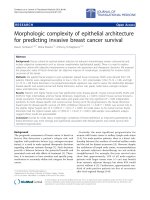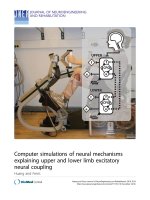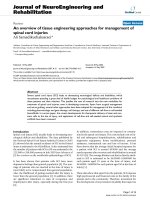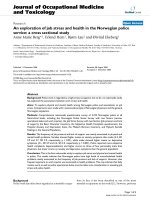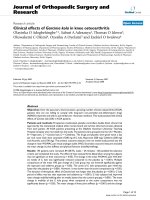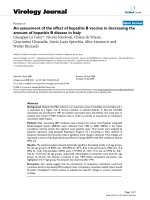báo cáo hóa học:" An overview of learning mechanisms for cognitive systems" doc
Bạn đang xem bản rút gọn của tài liệu. Xem và tải ngay bản đầy đủ của tài liệu tại đây (429.87 KB, 28 trang )
This Provisional PDF corresponds to the article as it appeared upon acceptance. Fully formatted
PDF and full text (HTML) versions will be made available soon.
An overview of learning mechanisms for cognitive systems
EURASIP Journal on Wireless Communications and Networking 2012,
2012:22 doi:10.1186/1687-1499-2012-22
Aimilia Bantouna ()
Vera Stavroulaki ()
Yiouli Kritikou ()
Kostas Tsagkaris ()
Panagiotis Demestichas ()
Klaus Moessner ()
ISSN 1687-1499
Article type Review
Submission date 20 May 2011
Acceptance date 19 January 2012
Publication date 19 January 2012
Article URL />This peer-reviewed article was published immediately upon acceptance. It can be downloaded,
printed and distributed freely for any purposes (see copyright notice below).
For information about publishing your research in EURASIP WCN go to
/>For information about other SpringerOpen publications go to
EURASIP Journal on Wireless
Communications and
Networking
© 2012 Bantouna et al. ; licensee Springer.
This is an open access article distributed under the terms of the Creative Commons Attribution License ( />which permits unrestricted use, distribution, and reproduction in any medium, provided the original work is properly cited.
1
An Overview of Learning Mechanisms for Cognitive Systems
Aimilia Bantouna
*1
, Vera Stavroulaki
1
, Yiouli Kritikou
1
, Kostas Tsagkaris
1
,
Panagiotis Demestichas
1
and Klaus Moessner
2
1
Department of Digital Systems, University of Piraeus, 80, Karaoli &
Dimitriou Str., Piraeus, Greece
2
Centre for Communication Systems Research, University of Surrey,
Guildford GU27XH, UK
*
Corresponding author:
Email addresses:
AB:
VS:
YK:
KT:
PD:
KM:
Abstract
Cognitive systems were first introduced by Mitola and in the last decade
they have proved to be beneficial in self-management functionalities of
future generation networks. The advantages and the way that networks gain
benefits from cognitive systems is analysed in this article. Moreover, since
such systems are closely related to machine learning, the focus of this article
2
is also placed on machine learning techniques applied both in the network
and the user devices side. In particular, celebrating 10 years of cognitive
systems, this survey-oriented article presents an extended state-of-the-art of
machine learning applied to cognitive systems as coming from the recent
research and an overview of three different learning capabilities of both the
network and the user device.
Keywords: learning; neural networks; Bayesian networks; self-organizing
maps (SOMs).
1. Introduction
The success of mobile networks has been driven by the services offered, i.e.
voice in second generation and multimedia services in third generation (3G)
networks. Similarly, a key issue for the success of future generation
networks is considered to be the provision of enhanced, always available,
personalised services. In addition to communication and entertainment, a
wide range of other life sectors can benefit from evolving multimedia
applications, including healthcare, environmental monitoring, transportation
and public safety. In this respect, it is necessary to develop mechanisms that
will enhance the end-user experience, in terms of quality of service (QoS),
availability and reliability. At the same time, the complexity and
heterogeneity of the infrastructure of mobile network operators increases as
radio access technologies (RATs) continue to evolve and new ones emerge.
3
In summary, fundamental requirements for the success of future networks
are service personalisation, always-best-connectivity, ubiquitous service
provision as well as efficient handling of the complexity of the underlying
infrastructure. All these call for self-management and learning capabilities in
future generation network systems. Self-management enables a system to
identify opportunities for improving its performance and
configuring/adapting its operation accordingly without the need for human
intervention [1] Learning mechanisms are essential so as to increase the
reliability of decision making. Learning mechanisms also provide the ground
for enabling proactive handling of problematic situations, i.e. identifying and
handling issues that could undermine the performance of the system before
these actually occur.
In this respect, cognitive, reconfigurable systems [2–4], encompassing self-
management and learning capabilities, have been devised as a solution to
address all the key issues identified in the previous. More specifically,
cognitive systems determine their behaviour, in a self-managed way. This is
achieved reactively or proactively [5–7], based on goals, policies,
knowledge and experience, obtained through learning. Towards this
direction, this article provides an overview of two network centric
applications based on two different learning techniques for identifying
network capabilities in terms of available QoS expressed in bitrate.
4
Moreover, as the mobile phone becomes more and more an indispensable
tool in daily activities, learning functionality is required on the user device
as well in order to truly enhance the experience of all users, even technology
agnostic ones. In this direction, the focus of this article is also placed in user
centric learning capabilities as well by exploiting a learning technique for
the identification of user preferences so as to connect to that network which
will increase quality of experience (QoE) for the user.
In more detail, the article is structured as follows. Sections 2 presents an
extended related work of functionalities built upon learning techniques and
Section 3 provides two problem statements, one of them being network
centric and one user centric. The two problems showcase the way that the
techniques can and/or should be used. The article continues in Section 4 with
the approaches that are followed in the problems stated in Section 3 by
overviewing the learning-based mechanisms for acquiring learning
capabilities both in network and user’s equipment. Finally, the article
concludes in Section 5.
2. Related study
For achieving the targets analysed above learning capabilities are required
both in network and user equipments. Looking from the side of the
management systems of the networks, learning capabilities can offer
enhancements to the system by providing knowledge regarding the
5
capabilities of the network and facilitating the decision-making mechanisms.
The applications presented in this article referring to network capabilities of
the system were expressed in terms of QoS, and more particularly in
achieved bitrate. On the other hand, learning capabilities in user devices
facilitate the building of knowledge regarding the user’s preferences and
thus improving QoE for the user.
Relevant past study includes research towards both directions. In particular,
regarding networks capabilities a large variety of research has been recorded
using enough different learning techniques. To begin with, the study in [8]
describes fuzzy logic schemes for representing the knowledge for cross-layer
information followed by fuzzy control theory which implements cross-layer
optimization strategies. Towards the same direction, authors of [9] suggest
fuzzy logic-based schemes which exploit past history and shared knowledge
of the service quality experienced by active connections for processing
cross-layer communication quality metrics so as to estimate the expected
transport layer performance.
Moving to bio-inspired techniques, genetic algorithms (GAs) have also been
proposed for similar reasons. More precisely, authors of [10] propose a GA
for achieving the optimal transmission with respect to QoS goals
(minimization of the bit-error rate, minimizing of power consumption,
maximization of the throughput, etc.). For this purpose, the GA scores a
6
subset of parameters and evolves them until the optimal value is reached for
a given goal.
Furthermore, neural networks (NNs) have also been used for treating similar
problems. Only a few examples coming from the recent literature and using
NN-based techniques are [11–13]. Authors of [11] propose NN-based
learning schemes with the aim to predict the data rate of a candidate radio
configuration, which is to be evaluated by a cognitive radio system (CRS).
Several NN-based schemes have also been tested in [12] for similar
purposes. Therein, data rate is studied with respect to the quality of the link
and the signal strength of the wireless transceiver, while scenarios that test
the possibility of predicting the actual achieved throughput, in a short-term
fashion in environments that are rapidly changing, also exist. Learning and
predicting the performance is also the target of the cognitive controller built
using multilayer feed-forward neural network [13]. The controller performs
this task for different channels in IEEE 802.11 wireless networks based on
the experimental measurements and the environmental conditions, and
eventually selects the optional channel.
Finally, Bayesian statistics and self-organizing maps (SOMs) have also been
applied as techniques that can facilitate the estimation of network capacity.
Among the articles that report so are [14–16], respectively. The specific
approaches are selected to be further analysed in the next sections.
7
Looking from the user preferences side, effort was put on developing
context awareness techniques [17–20], recording of user preferences [21, 22]
and learning capabilities [11, 14] and exploiting these to influence the
configuration selection [23–25]. Additionally, relevant work also includes
the use of Bayesian networks in support of user modelling, as a method for
evaluating, in a qualitative and quantitative manner, elements of the user
behaviour and consequently updating the user profile. In this direction,
diverse research efforts have utilised concepts of Bayesian statistics for
various applications such as recommendation systems [26, 27], negotiations
[28] and calendar scheduling [29]. Issues that arise in achieving user-intent
ascription through dynamic user model construction with Bayesian networks
are addressed in [30].
The work presented in [31] focuses especially on the application of Bayesian
statistics concepts for learning user preferences regarding the provision of
services in mobile and wireless networks, such as voice, video streaming,
web browsing, etc. In general, in the scope of mobile networks and
ubiquitous computing, similar schemes have been developed. However,
these focus on different aspects of user preferences and not on user
preferences regarding the obtained QoS when using a certain
service/application. For example, in [32] the targeted user preferences are
modifications of the ringer volume or vibrate alarm and the acceptance or
rejection of incoming calls. In [33], where the design for a context-aware
collaborative filtering system is presented, the focus is on user preferences
8
regarding activities in certain contextual situations. The challenges in
progressing from modelling human behaviour to inferring human intent in
context aware applications are addressed in [34], where the focus is more on
ubiquitous virtual reality applications.
In summary, while a great amount of research efforts have focused on
approaches for acquiring, learning and exploiting information on user
preferences, the targeted user preferences, as well as the objectives, vary
between the different approaches. The scheme for learning user preferences
in [31] concentrates on preferences regarding service provisioning, in terms
of QoS levels, for various services available in mobile and wireless
networks. As the aim of [31] was to dynamically estimate user preferences
and exploit these estimations in the selection of the most appropriate device
configuration, so as to achieve the “always-best” connectivity concept and
subsequently provide an enhanced experience to the user, it was selected to
be presented in more details hereafter (see Section 4).
The main innovation of the study presented in this article lies in the fact that
the article presents an approach for dynamically learning both context
information and user preferences, the combination of which could be
exploited in a later stage for the selection of the most appropriate network
configuration. It is important here to clarify that the selection itself is out of
the scope of this article.
9
3. Problem statement
3.1. Learning network capabilities
The aim of this problem is to estimate network capabilities. The term
“network capabilities” refers to what the network is capable of, i.e. the main
features of a network such as the QoS, its range, its location, its type (GSM,
UMTS), etc. In thisarticle, the term refers explicitly to the QoS that the
network may offer. Consequently, QoS may also refer to more than one
parameter, such as the bitrate, the jitter, the delay, the bit error rate and the
throughput of the network. In this case, QoS is mentioned in terms of
achievable bitrate. Summarizing, the scope of this case is to estimate
network capabilities in terms of QoS, expressed in bitrate, based on current
network measurements and context. It is worth mentioning at this point that
by network measurements, measurements that refer to parameters holding
information related to the network identity, its RAT, its configuration, its
Received Signal Strength Identifier (RSSI) and its traffic, in terms of packets
or Bytes, are considered. Moreover, context refers to those parameters that
hold information such as time, location and the environmental conditions.
3.2. Learning user preferences
This problem targets at dynamically learning user preferences regarding the
perceived QoS level per service/application and potentially, the maximum
acceptable price per service/application [31]. The aim is to estimate the most
10
likely user preferences/satisfaction for a specific service, QoS level, location
and time zone.
The user profile has been modelled as a collection of parameters that can be
classified in two main groups: observable and output parameters. Observable
parameters include the currently running services/applications,
corresponding QoS levels and associated QoS parameters, location, time
zone and provided user feedback. User feedback is obtained in the following
manner. The user initiates a specific service. At the initial stages it is
considered that the user does not have any particular preferences. In other
words, the user is initially considered to be indifferent between service
provision choices. Every time the user obtains a service, a rating facility,
embedded in the learning mechanism, allows the user to rate how much
he/she liked the particular service provision. A Likert scale [35] is used for
the rating, i.e. five different rating options are provided. In this way even
non-technology expert users can provide the system with feedback on their
preferences. The user is also given the choice to decline providing a rating.
Output parameters depend on the value of observable parameters. Their
value is dynamically updated over time. Output parameters represent the
most appropriate configuration for the specific user in a certain context (user
role/profile which encompasses certain location and time zone aspects). For
the sake of simplicity the focus here is on one output parameter, namely the
utility value. Other output parameters include for example the maximum
acceptable price that the user is willing to pay in order to be provided a
11
certain service at a specific QoS level. The utility value, a concept used in
decision making theory and microeconomics, is used to represent user
preferences for QoS levels when making use of a certain service. In other
words, the utility value provides a ranking, by order of preference of service
and QoS combinations. User preferences may vary depending on the
contextual situation and may change over time. Therefore, the utility value is
assumed to depend on a range of context-related parameters, as mentioned in
the previous. More specifically, the utility value, apart from the service and
QoS level, may be related to the location of the user, the time zone, and the
feedback obtained from the user. The utility value for a QoS level may also
implicitly correspond to a set of weights per QoS parameter (such as bit rate,
delay, jitter, etc).
4. Approaches
4.1. Network capabilities using SOM
An approach adopted in recent literature refers to learning network
capabilities using the unsupervised learning technique known as SOMs. The
elements that serve as inputs for discovering the QoS in this approach refers
to parameters that are obtained given a configuration, e.g. RSSI, number of
input Bytes, etc. On the other hand and as already stated, the parameter that
expresses the QoS is the bit rate.
12
According to the technique applied here, SOM is used for mapping
multidimensional data in a 2D-map. To do so, SOM requires a training
process where the data are converted in data samples and, finally, in vectors
which are mapped with respect to their resemblance. Each inserted vector
too the training process updates the vector of the map that is closest to it
according to Euclidean distance so as similar data samples to come closer to
each others. As a result, similar vectors are mapped to the same cluster, i.e.
group of vectors. Thus, the created map depicts the clustering of the data and
the pattern of their relationship.
At this point, it is essential to clarify that the term “data sample” differs from
the term “data” in the fact that a data sample consists of more than one data.
In fact, each data sample is a combination of values, each of which refers to
a different observed parameter.
Continuing on the analysis of the technique, as soon as the pattern has been
recognised based on the resemblance of the vectors that were used for the
training and the map has been trained and designed, a new data sample can
be mapped on it with respect to the vector of the map that is closest to it
when using Euclidean distance. Moreover, according to the SOM theory,
data samples that belong in the same cluster are expected to be similar to
each other. In our case, this means that the bit rate observed at the same time
with the parameters that formulate one data sample of the cluster is expected
to be the same with the respective bit rate of the other data samples of the
13
same cluster. Thus, for inferring the network capacity all that is left to be
done is to identify the cluster in which the new entry belongs. These last
features of SOM technique also constitute the basis of the learning
technique. Further information about the technique can be found in [15].
4.2. Network capabilities using Bayesian statistics
This approach is also devoted to the presentation of learning capabilities
which facilitate the estimation of the network capabilities. In this approach,
the mechanism is based on the correlation of candidate transmitter
configurations with the QoS, in terms of bit rate, that is offered by the
network given this configuration. In particular, the learning mechanism
exploits the knowledge and the past experience by enforcing them with
Bayesian statistics techniques suitable for reasoning about probabilistic
relationships [36–38].
More specifically, since the goal is to associate different configurations of a
transmitter with the bitrate, the probability to obtain a specific network
capacity BR
i
given the configuration CFG
i
is calculated. This calculation
and its frequent update constitute the basis of this technique. The update of
these relies on approaches suggested in [36, 38–40].
To begin with, using the Shannon theorem and gathering the necessary
information for each configuration makes it possible to calculate the
available bit rate for each configuration. Furthermore, using all possible
14
combinations of configurations and bit rate, conditional probabilities of the
form Pr
kj
[BR
k
|CFG
j
] can be calculated. These probabilities are then
organised in conditional probability tables (CPTs) of the form of Table 1. In
these CPTs each column represents a different configuration while each row
corresponds to a different reference value of bit rate. These reference bit
rates comprise the set of available BRs which in this case was selected to be
discrete [41].
Finally, using the CPTs, it is easy to identify the most probable bit rate given
a configuration. In fact, it will be the one which is associated to the highest
conditional probability in the respective configuration column. Further
information about the results and the mathematical background of the
technique can also be found in [14].
4.3. User preferences using Bayesian statistics
The functionality for learning user preferences is realised with the use of
Bayesian statistics concepts [39]. The aim is to estimate the probability of
the level of user satisfaction for a specific service and perceived QoS level,
given a certain location and time zone. In other words, conditional
probabilities for the utility value are calculated. More specifically, a method
has been implemented according to which instantaneous estimations are
updated by taking into account existing (historical) information on the user.
The process of developing knowledge on user preferences can be roughly
15
divided in two phases. The initial phase is collecting information on user
preferences. The second phase deals with the estimation of future user
preferences based on the information collected. More specifically, it is
assumed that values for the observable parameters are recorded for various
instances (phases). These values constitute the “observable parameters
evidence”. Based on the observable parameters evidence, the instantaneous
(conditional) probabilities for the utility value are calculated. The next step
of this procedure is the calculation of adapted (conditional) probabilities
through Equation (1), where n is the current instance, P
adapted,n
denotes the
adapted probability estimation for instance n, P
adapted,n-1
stands for the current
instantaneous estimation and parameters w
hist
and w
instant
reflect the weights
attributed to the historical and the current instantaneous estimation,
respectively, with values in the interval (0,1). The latter also comply with
Equation (2).
adapted, hist adapted, instant adapted, 1 inst
ant, instant,
* 1 *(1 | |)*
n n n n n
P w P w P P P
−
= − + − −
(1)
hist instant
1
w w
+ =
(2)
The calculated probabilities yield the most likely user preferences per QoS
level, which in turn can be used as input in a decision-making mechanism
for deciding, for instance, on the most appropriate configuration of user’s
device. An overview of the process for learning user preferences is depicted
in Figure 1Error! Reference source not found More information
regarding the mathematical formulation and the algorithm for the
16
functionality for dynamically learning user preferences, as well as the data
structures and elements it utilises can be found in [31].
4.4. Appraisal
Comparing the two approaches presented for learning network capabilities,
Bayesian statistics offer also the possibility of online training. The latter
abstracts the necessity of explicitly storing past observations, a feature that
doesn’t exist in SOM. As a result, the approach minimises the required
memory capacity and thus it could also be applied from a user device
perspective. If so, then the device would become for example capable of
certifying that the offered network capability indeed reaches the value that is
claimed by the network.
In addition, comparing the two problems that were identified and
overviewed above, they are found to be interrelated. Their interrelation lies
in the fact that the combination of a dynamical learning of context
information and user preferences could be exploited in a later stage for the
selection of the most appropriate network configuration. It is worth
mentioning at this point that this mechanism is out of the scope of this
article.
17
5. Conclusions
The article presented an overview of applications of machine learning for
building knowledge on environment characteristics (context) and user
preferences. In particular, the article provided an extended overview of
related study in the field of learning in cognitive systems and focused on two
problems of recent literature followed by an overview of the applied
approaches. More specifically, learning mechanisms were presented for
building knowledge on network capabilities in terms of QoS, and more
specifically in terms of bitrate, and on user preferences, in terms of user
satisfaction for the achieved QoS, given the service, the time and the
location of the user.
Competing interests
The authors declare that they have no competing interests.
Acknowledgements
This study was performed in the framework of the E3 project National
Participation, funded by the General Secretariat of Research and Technology
(GSRT) of the Greek Ministry of Development and evolved in the context of
the OneFIT (Opportunistic networks and Cognitive Management Systems
for Efficient Application Provision in the Future InterneT, www.ict-
18
onefit.eu) Project. Furthermore, evolved versions of this study support
training activities in the context of the ACROPOLIS (Advanced coexistence
technologies for Radio Optimisation in Licenced and Unlicensed Spectrum -
Network of Excellence) project (). This article
reflects only the authors’ views and the Community is not liable for any use
that may be made of the information contained therein.
References
[1] J Kephart, D Chess, The vision of autonomic computing. IEEE
Comput. 36(1), 41–50 (2003). doi:10.1109/MC.2003.1160055
[2] R Thomas, D Friend, L DaSilva, A McKenzie, Cognitive networks:
adaptation and learning to achieve end-to-end performance objectives.
IEEE Commun. Mag. 44(12), 51–57 (2006).
doi:10.1109/MCOM.2006.273099
[3] FP7/ICT project E³ (End-to-End Efficiency) (ICT-2007-216248),
January 2008–December 2009. Accessed 29
September 2011
[4] Wireless Innovation Forum.
Accessed 29 September 2011
19
[5] J Mitola III, GQ Maguire Jr, Cognitive radio: making software radios
more personal. IEEE Personal Commun. 6(4), 13–18 (1999).
doi:10.1109/98.788210
[6] S Haykin, Cognitive radio: brain-empowered wireless
communications. IEEE J. Sel. Areas Commun. 23(2), 201–220
(2005). doi:10.1109/JSAC.2004.839380
[7] J Mitola, Dissertation (Royal Institute of Technology, KTH, Sweden,
2000)
[8] N Baldo, M Zorzi, Fuzzy logic for cross-layer optimization in
cognitive radio networks. Paper presented at the 1st IEEE Workshop
on Cognitive Radio Networks (in conjunction with IEEE CCNC 2007),
Las Vegas, Nevada, USA, 11–13 January 2007, pp. 1128–1133
[9] N Baldo, M Zorzi, Cognitive network access using fuzzy decision
making. IEEE Int. Commun. ICC 2007, 6504–6510 (2007).
doi:10.1109/ICC.2007.1076
[10] TR Newman, BA Barker, AM Wyglinski, A Agah, JB Evans, GJ
Minden, Cognitive engine implementation for wireless multicarrier
transceivers. Wirel. Commun. Mob. Comput. 7(9), 1129–1142 (2007).
doi:10.1002/wcm.v7:9
20
[11] K Tsagkaris, A Katidiotis, P Demestichas, Neural network-based
learning schemes for cognitive radio systems. Comput. Commun.
31(14), 3394–3404 (2008). doi:10.1016/j.comcom.2008.05.040
[12] A Katidiotis, K Tsagkaris, P Demestichas, Performance evaluation of
artificial neural network-based learning schemes for cognitive radio
systems. Comput. Electric. Eng. 36(3), 518–535 (2010).
doi:10.1016/j.compeleceng.2009.12.005
[13] N Baldo, BR Tamma, BS Manoj, R Rao, M Zorzi, in Abstracts of the
2009 IEEE international Conference on Communications, Dresden,
Germany, 14–18 June 2009, pp. 1–5
[14] P Demestichas, A Katidiotis, K Tsagkaris, E Adamopoulou, K
Demestichas, Enhancing channel estimation in cognitive radio
systems by means of Bayesian networks. Wirel. Personal Commun.
49(1), 87–105 (2009). doi:10.1007/s11277-008-9559-1
[15] A Bantouna, K Tsagkaris, P Demestichas, in ICAAN 2010: Artificial
Neural Networks – ICANN 2010 PART II, ed. by K Diamantaras, W
Duch, LS Iliadis. 20th International Conference on Artificial Neural
Networks (ICANN 2010), Thessaloniki, Greece, September 2010.
LCNS, vol. 6353 (Springer-Verlag, Heidelberg, 2010), p. 382
[16] A Bantouna, K Tsagkaris, P Demestichas, in EUREKA! 2010, ed. by
TS Papatheodorou. 1st International Conference for Undergraduate
21
and Postgraduate Students in Computer Engineering, Informatics,
Related Technologies and Applications 2010 (Eureka! 2010), Patras,
Greece, October 2010. Proceedings 4
th
Scientific Conference for
undergratuated and graduate students in Informatics and Related
Applications, Department of Computer Engineering & Informatics,
University of Partas, 2010, p. 41
[17] MJ Van Sinderen, AT Van Halteren, M Wegdam, HB Meeuwissen, E
Henk Eertink, Supporting context-aware mobile applications: an
infrastructure approach. IEEE Commun. Mag. 44(9), 96–104 (2006).
doi:10.1109/MCOM.2006.1705985
[18] M Gandetto, A Cattoni, C Regazzoni, in Abstracts of the Software
Defined Radio (SDR’ 05) Technical Conference, Anaheim, USA, 14–
18 November 2005
[19] P Bellavista, A Corradi, R Montanari, A Tononelli, Context-aware
semantic discovery for next generation mobile systems. IEEE
Commun. Mag. 44(9), 62–71 (2006).
doi:10.1109/MCOM.2006.1705981
[20] H Kim, KG Shin, Efficient discovery of spectrum opportunities with
MAC-layer sensing in cognitive radio networks. IEEE Trans. Mob.
Comput. 7(5), 533–545 (2008). doi:10.1109/TMC.2007.70751
22
[21] K Demestichas, A Koutsorodi, E Adamopoulou, M Theologou,
Modelling user preferences and configuring services in B3G devices.
Wirel. Netw.14(5), 699–713 (2008). doi:10.1007/s11276-007-0044-7
[22] E Homayounvala, AH Aghvami, User preference modelling for access
selection in multiple radio access environments. IEICE Trans.
Commun. EE88-B(11), 4186–4193 (2005). doi:10.1093/ietcom
[23] X Liu, NS Shankar, Sensing-based opportunistic channel access. Mob.
Netw. Appl. J.11(4), 577–591 (2006). doi:10.1007/s11036-006-7323-
x
[24] J Perez-Romero, O Sallent, R Agusti, L Giupponi, A novel on-
demand cognitive pilot channel enabling dynamic spectrum
allocation, in 2nd International Symposium on New Frontiers in
Dynamic Spectrum Access Networks 2007 (DySPAN 2007), Dublin,
Ireland, pp. 46–54, 2007. doi:10.1109/DYSPAN.2007.14
[25] K Nolan, L Doyle, Teamwork and collaboration in cognitive wireless
networks. IEEE Wirel. Commun. Mag. 14(4), 22–27 (2007).
doi:10.1109/MWC.2007.4300979
[26] L Coyle, P Cunningham, in ECBR 2004, ed. by P Funk, PAG Calero.
Advances in Case-Based Reasoning, 7th European Conference,
ECCBR 2004, Madrid, Spain, August/September 2004. Lecture Notes
in Computer Science (including subseries Lecture Notes in Artificial
23
Intelligence and Lecture Notes in Bioinformatics), vol. 3155
(Springer, Heidelberg, 2004), p. 560
[27] Y Zhang, J Koren, In Abstracts of the SIGIR’07, Amsterdam,
Netherlands, 23–27 July 2007, pp. 47–54
[28] Y Guo, JP Müller, C Weinhardt, in CEEMAS'03 Proceedings of the
3rd Central and Eastern European Conference on Multi-Agent
systems, ed. by V Marík, JP Müller, M Pechoucek. 3rd
International/Central and Eastern European Conference on Multi-
Agent Systems, Prague, Czech Republic, June 2003. Lecture Notes in
Artificial Intelligence (subseries of Lecture Notes in Computer
Science) vol. 2691 (Springer, Heidelberg, 2003), p. 303
[29] J Oh, SF Smith, in PATAT, ed. by EK Burke, MA Trick. 5th
International Conference on Practice and Theory of Automated
Timetabling (PATAT), Pittsburgh, PA, USA, August 2004. Lecture
Notes in Computer Science (including subseries Lecture Notes in
Artificial Intelligence and Lecture Notes in Bioinformatics) LNCS
vol. 3616 (Springer, Heidelberg, 2004), p. 3
[30] E Santos Jr, S Brown, M Lejter, G Ngai, S Banks, M Stytz, in
Proceedings of the 12
th
International Florida Artificial Intelligence
Research Society Conference, ed. by AN Kumar, I Russell. Orlando,
FL, 1999. (AAAI Press, Menlo Park, CA, 1999), p. 3
24
[31] V Stavroulaki, Y Kritikou, P Demestichas, Acquiring and learning
user information in the context of cognitive device management, in
IEEE International Conference on Communications (ICC), pp. 1–5,
2009. doi:10.1109/ICCW.2009.5208053
[32] A Krause, A Smailagic, DP Siewiorek, Context-aware mobile
computing: learning context-dependent personal preferences from a
wearable sensor array. IEEE Trans. Mob. Comput. 5(2), 113–127
(2006). doi:10.1109/TMC.2006.18
[33] A Chen, in LoCA 2005, ed. by T Strang, C Linnho-Popien. Workshop
on Location- and Context-Awareness (LoCA 2005),
Oberpfaffenhofen, Germany, 2005. LNCS vol. 3479 (Springer,
Heidelberg, 2004), p. 244
[34] A Dey, Modeling and Adding Intelligibility to Human Activity (IEEE
Computer Society, Washington, 2008), pp. 5–8.
doi:10.1109/ISUVR.2008.25. (also available in the abstracts of the
International Symposium on Ubiquitous Virtual Reality, Gwangju,
Korea, 10–13 July 2008)
[35] R Likert, A technique for the measurement of attitudes. Arch.
Psychol. 22(140), 1–55 (1932)
[36] RE Neapolitan, Learning Bayesian Networks (Prentice-Hall Series in
Artificial Intelligence, NJ, 2003)

